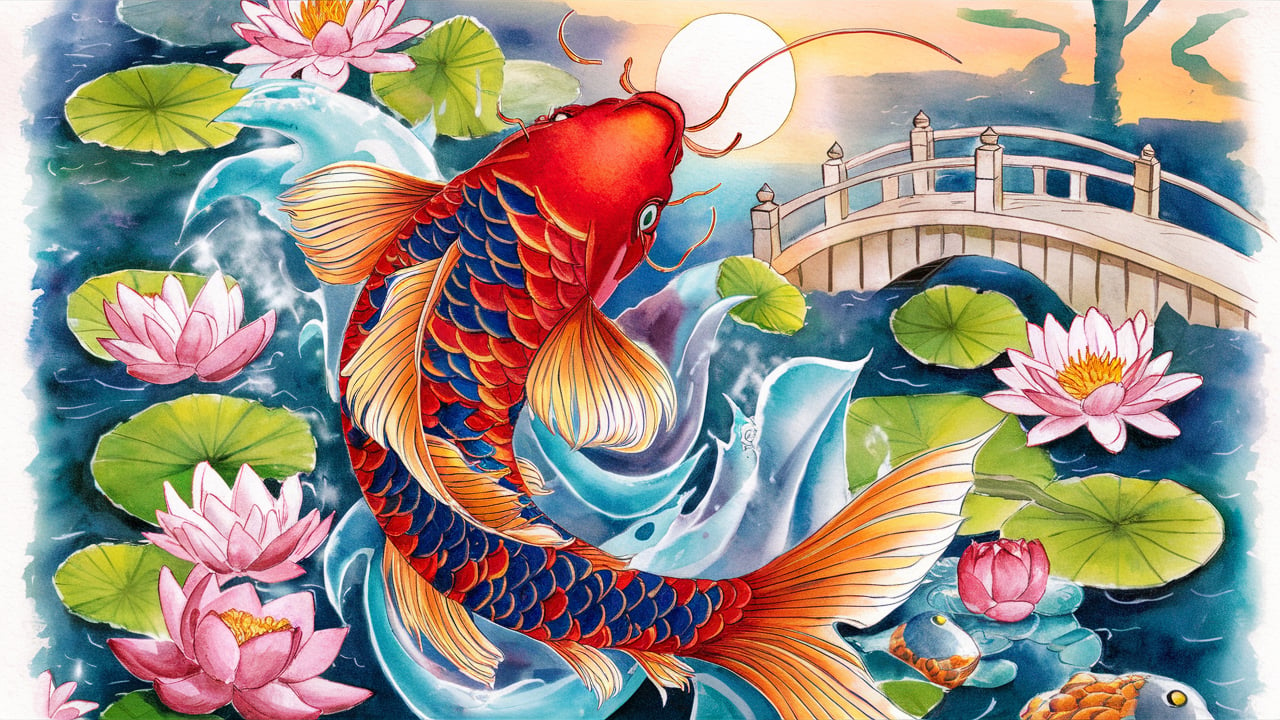The koi, with its vibrant scales and graceful movements, is more than just a beautiful fish. What does the koi represent? In this post, Koi Fish Beauty will explore the layers of meaning behind the koi, uncovering the stories, beliefs, and interpretations that have made it a cherished icon across the world.
The Emergence of Koi in Culture
Koi, also known as Japanese carp, have a fascinating history that intertwines with the cultural landscape of East Asia, particularly Japan and China. Their journey from ordinary carp to cultural icons is a testament to their captivating beauty and symbolic significance.
Origins in Japan
- Koi originated as a selectively bred variety of the common carp (Cyprinus carpio), first appearing in Japan during the Edo period (1603-1868).
- The Japanese, known for their appreciation of beauty and symbolism, quickly embraced the koi, recognizing its potential as a subject for art, poetry, and even philosophical contemplation.
Cultural Significance
- Koi became deeply ingrained in Japanese culture, symbolizing perseverance, strength, and good fortune.
- Their vibrant colors and graceful movements were seen as a reflection of the beauty and harmony found in nature.
- The koi’s association with the “Carp Leaping Over the Dragon Gate” legend further cemented its status as a symbol of ambition, determination, and the pursuit of higher goals.
Spread Beyond Japan
- The koi’s popularity extended beyond Japan, captivating the hearts of people in other parts of East Asia and eventually reaching the West.
- Their beauty and symbolism resonated with cultures worldwide, making them a popular choice for ornamental ponds, gardens, and even tattoos.
Modern Relevance
- Today, koi continue to hold a special place in both Eastern and Western cultures.
- They are celebrated for their beauty, elegance, and the powerful messages they convey about perseverance, ambition, and the pursuit of dreams.
- Koi are a reminder of the enduring power of symbolism and the beauty that can be found in the natural world.
What Does The Koi Represent?
Here are some key interpretations of what the koi represents:
Perseverance and Determination
The koi’s relentless journey upstream, often depicted in the “Carp Leaping Over the Dragon Gate” legend, symbolizes the importance of perseverance in the face of obstacles. It represents the strength and determination needed to overcome challenges and achieve one’s goals.
Strength and Resilience
The koi’s ability to navigate strong currents and leap over obstacles represents inner strength and resilience. It embodies the ability to overcome adversity and emerge stronger.

Good Fortune and Success
The koi’s transformation into a dragon in the “Carp Leaping Over the Dragon Gate” legend is seen as a symbol of good fortune, success, and the realization of one’s potential. It represents the achievement of ambitious goals and the attainment of prosperity.
Harmony and Beauty
The koi’s vibrant colors and graceful movements are often seen as a reflection of the beauty and harmony found in nature. It represents the balance and interconnectedness of life.
Love and Friendship
In some cultures, the koi is also associated with love and friendship. The koi’s graceful movements and vibrant colors are seen as a reflection of the beauty and joy found in these relationships.
The Koi’s Significance in Art, Poetry, and Philosophy
Art
- Japanese Art: Koi are frequently depicted in Japanese art, particularly in paintings, sculptures, and woodblock prints. Their beauty and symbolism are often used to convey themes of perseverance, ambition, and the pursuit of dreams. Famous examples include the woodblock prints of Utagawa Kuniyoshi, where koi are often depicted swimming upstream, symbolizing the struggle for success.
- Tattoos: Koi tattoos are popular worldwide, often signifying strength, perseverance, and good fortune. The vibrant colors and intricate designs make them visually stunning and deeply meaningful.
Poetry
- Haiku: The koi’s journey, its beauty, and its symbolism have inspired countless poems and songs, often exploring themes of nature, transformation, and the human spirit. In haiku, the koi is often used as a metaphor for the fleeting nature of life and the importance of living in the present moment.
- Tang Poems: In Chinese poetry, the koi is often associated with themes of love, beauty, and the passage of time. Tang Dynasty poets, known for their lyrical and evocative style, often used the koi as a symbol of the beauty and fragility of life.
Philosophy
- Zen Buddhism: The koi’s symbolism has also been explored in Japanese philosophy, particularly in Zen Buddhism. It is seen as a representation of the interconnectedness of all things, the importance of perseverance, and the potential for transformation. The koi’s journey upstream is often seen as a metaphor for the spiritual path, where one must overcome obstacles and challenges to reach enlightenment.
- Confucianism: In Confucianism, the koi is often associated with the importance of filial piety, loyalty, and the pursuit of knowledge. The koi’s journey upstream is seen as a metaphor for the lifelong pursuit of self-improvement and the fulfillment of one’s potential.
In conclusion
What does the koi represent? Koi are a unique cultural symbol with deep meaning in East Asian culture. They are considered symbols of good luck, prosperity, and strength. Koi are also beautiful ornamental fish, loved and raised by many people.

Related Posts
The Biggest Koi Fish: A Fascinating Look at Giant Koi
How Old Can Goldfish Live? Unlocking The Secrets
Dragon Siamese Fighting Fish Female: A Guide to Peaceful Coexistence